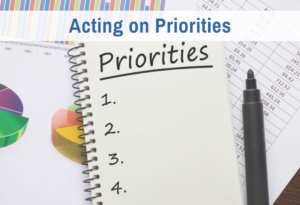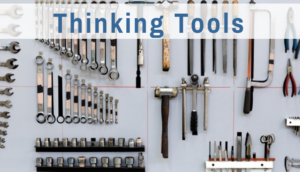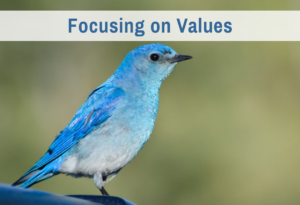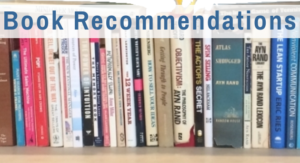My mother had a few one-liners she used to encourage us. If you were in a funk, she would say, “You need to stand on your head.” If you faced a daunting task, she would say, “Effort, St. Swithins!” I never did learn how to stand on my head, nor why St. Swithins should be called upon, but I did learn how to exit a funk and put in sustained effort on a daunting task — which is needed to get out of a funk!
Effort — sustained effort — is critical to managing your mind and achieving ambitious goals. Sometimes people get confused when I say this because I also argue against using pressure and “self-discipline” to make yourself perform, since neither of those is consistent with happiness. What’s the difference? It’s the difference between using your mind highly intentionally and forcing your mind.
Effort versus strain
Thinking, concentrating, introspecting emotions, making decisions — all of these mental processes take energy. None of them move forward without your taking the initiative to start and to keep going, especially once you hit a mental roadblock like confusion or conflict. The process can be exciting and energizing when it goes well. But it can also be tiring and unpleasant when it doesn’t. That’s when you really notice that it takes effort to keep going — and that’s when you need to call on St. Swithins to keep at it. You need a creative way to ensure the effort pays off sufficiently as you go, so you don’t drain your energy reserves.
The mistake that people make at this moment is that instead of getting creative, they pressure themselves to keep going. They shut down any aversion to exerting effort and force themselves to take predetermined steps. This creates a feeling of strain. Ultimately, straining burns you out. When you’re exercising, it’s good to exert lots of effort, but not if you’re straining a muscle. Ultimately, that leads to injuries. Similarly, it’s good to exert lots of effort in thinking, but not if you strain your mind.
For example, suppose you got confused trying to put together your resume. Suppressing the feeling to just force yourself to fill out your job history will make the process excruciating. If you succeed in finishing, you will probably hate the results, and you’ll definitely hate the prospect of updating it because your memory of the experience is so awful. In contrast, if you introspect the confusion and take it seriously, you can untangle it. This will give you a lead for how to make the resume better and that will give you a little second wind. By sustaining effort without strain, you re-energize so you can keep going.
Determination versus duty
Committing to this kind of sustained effort, you can decide to do a task “no matter what,” without relying on a sense of duty.
When you go by duty, you view the task as an out-of-context absolute that you have to do no matter how you feel. This means that if you experience any contrary motivation, you ignore it as irrelevant.
In contrast, to sustain effort without strain, you commit to paying a lot of attention to how you feel. If you feel resistance to starting, you need to look at it head-on to see if there is a legitimate problem to be solved or if there is just some old baggage holding you back. If it’s a real problem, you then solve it or finesse it. If it’s just old baggage, then you call on a sense of determination, not duty, to follow through.
“Determination” is a type of confidence. It is an emotion based on the conclusion that you can do what you think is rational even if it is unpleasant. (Unpleasant, not painful.) You will not become a drama queen or king when the going gets rough. Instead, you will draw on your emotional resilience to put the difficulties in perspective, mitigate any negative affect, and remind yourself of why this is a rational undertaking. If you find that you don’t have enough emotional resilience to put things in perspective, you give yourself a short emotional break, get a little emotional distance, then come back to the issue. This is how you reprogram your value hierarchy and untangle old baggage.
It is this self-correcting process that I call self-direction, which you do “no matter what.” By relying on determination instead of duty, you learn something about yourself, your emotional resilience, and your old baggage, all of which helps you manage your motivation better and develop more skills. For example, when people first learn self-direction, I recommend they give themselves a 10-minute limit of struggling to follow through before they do some kind of course-correction process. But once they have more emotional resilience, they can do a 75-minute “sprint,” which they expect to be unpleasant, in order to speed up the process of motivational reprogramming.
Vulnerability versus suppression
The key to self-direction is emotional vulnerability. You need to be willing to feel the emotions that make a task unpleasant — especially frustration, guilt, and self-doubt. Experiencing those emotions is not painful per se, though it is quite unpleasant. The motive for suppressing these emotions is to avoid introspecting them. It can be painful to look at the negatives that underlie them. This is because there is often grief hovering around the edges of these emotions.
Grief is painful. Grief is the emotion you feel when you have lost a value. It tears your heart out. Letting yourself feel the grief is essential to the process of mourning. The way I teach the mourning process, you go deeper to understand the deep rational values represented by the value lost. This heals the pain because it helps you honor the value you lost and make its abstract value a permanent part of your soul. Seeing the value abstractly then enables you to find other concrete opportunities for gaining and keeping that kind of value.
If you do not let yourself feel the pain of grief, it keeps hovering around the edges, coloring all other negative emotions. This is because if you don’t face the loss, you never fully accept it. Your value hierarchy is never updated to reflect actual values you can gain and keep. As a result, you remain in continual internal conflict, feeling desires for things that are literally impossible. You fight the loss instead of moving on. This is the essence of suffering. That is the “dirty” pain of suffering, analogous to the pain of a festering wound. In contrast, the “clean” pain of grief is analogous to the pain of a wound that is healing properly.
Grief often hovers around the edges of frustration, guilt, and self-doubt because these feelings are often triggered by self-critical conclusions. Frustration suggests you’re trying and failing. Guilt suggests you haven’t lived up to your moral standards. Self-doubt suggests you are incapable of success. (This last is always false, but that doesn’t stop you from thinking it.)
But this makes it more important to introspect them. First, the underlying self-criticism may be false. Challenging those wrong ideas is critical to unleashing your creativity in the world. Second, the underlying self-criticism may have a grain of truth in it. Introspection may lead you to realize that you aren’t as skilled as you thought, or you aren’t as knowledgable as you thought, or you aren’t acting to gain and keep important values of yours.
If you want to be happy, you need to address such concerns directly. You cannot pursue goals while in effect deluding yourself about your knowledge, skills, or action. If the goal is important enough, it’s worth developing the knowledge and skills and putting in the effort (without strain!) to achieve it.
But none of this information critical to your happiness can be gained if you are unwilling to feel unpleasant emotions, introspect their meaning, and judge the validity of the underlying evaluations.
In my series of articles on happiness, I argue that you can’t feel joyous, positive emotions all of the time. 80% is a reasonable target to go after. That is because, if you want to be happy, you need to be willing to experience unpleasant and even painful emotions so you can process them, mitigate any underlying issues, and adjust course for success, sooner rather than later. The way you get to happiness is through determined effort to experience and understand all of your emotions, even the most unpleasant ones.








0 Comments